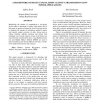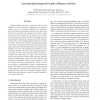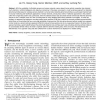16 search results - page 1 / 4 » Power-accuracy tradeoffs in human activity transition detect... |
92
Voted
DATE
2010
IEEE
15 years 5 months ago
2010
IEEE
— Wearable, mobile computing platforms are envisioned to be used in out-patient monitoring and care. These systems continuously perform signal filtering, transformations, and cla...
89
Voted
ICMCS
2009
IEEE
14 years 10 months ago
2009
IEEE
Minimizing the number of computations a low-power device makes is important to achieve long battery life. In this paper we present a framework for a low-power device to minimize t...
103
click to vote
ICIP
2006
IEEE
16 years 2 months ago
2006
IEEE
In order to summarize a video consisting of a sequence of different activities, there are three fundamental problems: tracking the objects of interest, detecting the activity chan...
247
Voted
ICCV
2011
IEEE
14 years 13 days ago
2011
IEEE
Complex human activities occurring in videos can be defined in terms of temporal configurations of primitive actions. Prior work typically hand-picks the primitives, their total...
112
Voted
TKDE
2008
15 years 9 days ago
2008
With the availability of affordable sensors and sensor networks, sensor-based human-activity recognition has attracted much attention in artificial intelligence and ubiquitous comp...



